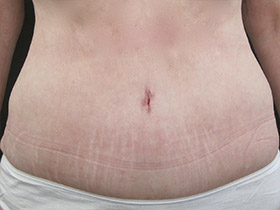Dramatic and see-saw weight losses can result in body image crises says UK’s leading female plastic surgeon Ms Angelica Kavouni
 A growing trend towards healthy lifestyle sees huge numbers of us increasing exercise and improving our nutrition, which in turn incurs (often) welcome weight losses. Much has been documented re the importance of maintaining a healthy *BMI and it’s great that the message is getting through. There is a tragic irony however – the +ve feelings caused by achieving target weight reduction can be severely offset by the -ve experience of having to face residual loose, flabby skin (most commonly around the stomach, breasts and upper arms).
A growing trend towards healthy lifestyle sees huge numbers of us increasing exercise and improving our nutrition, which in turn incurs (often) welcome weight losses. Much has been documented re the importance of maintaining a healthy *BMI and it’s great that the message is getting through. There is a tragic irony however – the +ve feelings caused by achieving target weight reduction can be severely offset by the -ve experience of having to face residual loose, flabby skin (most commonly around the stomach, breasts and upper arms).
Fad diets followed by binge eating are habits that many of us develop over our adult life and can result in large weight fluctuations. Youthful skin is generally able to bounce back thanks to high levels of collagen but as middle age looms skin can be left literally hanging.

 Patients who come to me for help generally ask for help to fix flabby arms, belly and sagging empty breasts. Before any surgery can be considered patients must be in good health and within a healthy BMI. Sometimes professional psychological and dietetic support is needed if they experience serial weight loss/weight gain issues.
Patients who come to me for help generally ask for help to fix flabby arms, belly and sagging empty breasts. Before any surgery can be considered patients must be in good health and within a healthy BMI. Sometimes professional psychological and dietetic support is needed if they experience serial weight loss/weight gain issues.
Ways to help reduce excessive loose skin during weight loss:
- Try to avoid fast, dramatic weight losses
- Once achieved try to maintain your target weight instead of yo-yo’ing
- Try to build muscle which can help to support the skin
- Sometimes a surgical support garment can help to contour the stomach area
- Include collagen boosting foods in your diet such as leafy greens and citrus, Omega-3 rich fish and grass fed meat
- Be careful in the sun – wear factor 20+ sunscreen when exposed
Of course surgery can help remove excess skin but it comes at a price which is scarring. Scarring can be extensive: under the forearm (brachioplasty ), across the bikini line (abdominoplasty) and also around the breasts (mastopexy). It’s essential for thorough pre operative consultations to ensure patients fully understand. Many go ahead regardless as they’re tired of covering up and want to show off their toned, post weight loss bodies.
The overall message needs to be to try to avoid excessive weight gain in the first place – something which is easier said than done. Yes, surgery can fix most issues but it is not the answer for all woes. Scarring, cost, protracted recoveries and future potential weight gains and losses all need to be given serious thought.
*BMI: The body mass index ( BMI ) is a measure that uses your height and weight to work out if your weight is healthy. The BMI calculation divides an adult’s weight in kilograms by their height in metres squared. For example, A BMI of 25 means 25kg/m2.

